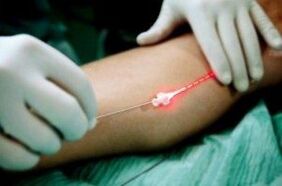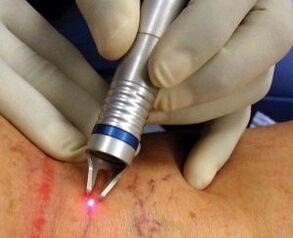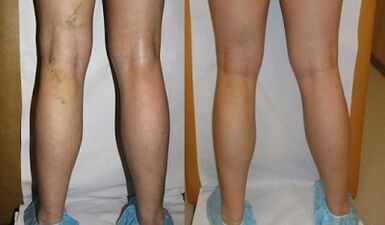
Treating varicose veins with a laser is a modern and effective way to get rid of this disease.
Laser therapy uses a concentrated radius of light, which causes damage to the veins and the growth of its connective tissue lumen.The blood flow through the thin vein ceases, which leads to the disappearance of the symptoms of the disease.
The principle of operation
If the patient has varicose veins in the leg, laser treatment is performed for the purpose of thermal effects on the wall of the vessel.This impact is caused by an irreversible decrease, replacement of connective tissue and the disappearance of the expanded vessel.
The main mechanism of action is the heating of the minimum amount of blood with the formation of steam, which damages the vascular wall.A diode laser with different size and fiber optical structure is used.
To compile a varicose veins, an ultrasound study is used.An analgesic substance is inserted into the area of intervention.A very thin optical fiber is inserted into the varicose vein, from the top of which a laser beam emerges.
Laser's energy is transformed into heat.The temperature inside the ship reaches 60 - 70 degrees.The heat effect on the vein wall leads to its "climbing".Then, over time, the sclerosis vein is absorbed.
Indications
Laser treatment of varicose veins is performed in two main methods:
- Perkutan;
- Intravascular (endovascular).

Limiting laser therapy helps to get rid of vascular stars and small subcutaneous veins.This procedure is performed for a cosmetic purpose.It can be used as the second stage of treatment after eliminating large varicose veins using surgery, sclerotherapy or endovascular therapy.
The endovascular method is used to eliminate large varicose veins.
If there are varicose veins in the legs, laser treatment allows you to influence such vessels:
- large and small subcutaneous;
- front front and back subcutaneous back;
- Surface subcutaneous;
- The anterior and back envelope of the femur.
Laser therapy is particularly shown to obese patients, as sclerotherapy or phlebectomy in such patients is difficult to be technically or can lead to complications.
Indications for endovascular coagulation:
- Ineffective valve surgery, accompanied by edema (reflux for money -apoplerography of more than 0.5 s);
- Disordishes trophic disorders: a change in color and skin density, dryness and itching of the skin;
- Harsse ulcer, difficult to treat.
The main symptoms in which laser treatment is shown:
- Lomota standing;
- severity and fatigue;
- feeling of pulse;
- itching of the skin;
- at night convulsions;
- Under the skin hemorrhages.
Skin changes:
- vascular stars, eczema, color change;
- white skin atrophy seals;
- ulcers;
- swelling;
- Inflammation of the surface veins.
Contraindications
Endovascular laser therapy is contraindicated in the following cases:
- pregnancy and breastfeeding in which anesthesia can damage the baby;
- difficulty in the blood flow through the deep veins, which will prevent normal blood flow after surgery;
- liver failure or allergies to pain sedatives;
- blood clotting disorders;
- Impossibility of properly treatment and observation after intervention;
- Blood casting (reflux) in the overlapping veins;
- Thrombosis, adhesions or vein tolerance.
The advantages of the method

Laser vein coagulation is a safe and effective method for treating varicose veins on outpatient basis under local anesthesia.The procedure lasts 1 - 1.5 hours.Most patients are satisfied with the result of treatment.
The total cost of intervention is lower than surgical surgery.Its effectiveness in terms of 3 months to 4 years reaches 93 - 100%.
Laser therapy does not lead to the formation of wounds and wounds.Is well tolerated and allows you to quickly restore normal activity.The side effects of the procedure rarely arise.
Flaw
Laser treatment of varicose veins may be associated with the following consequences:
- skin burning;
- change in skin color;
- nearby nerve damage, accompanied by burning or tingling (the probability of this is much lower than during ordinary surgery);
- Vienna thrombosis.
The more the experience of a doctor who performs the removal of the boat with a laser, the better the result of treatment.
Endoxic coagulation cannot be performed with the vein coast, for the treatment of large varicose joints, as well as a diameter of the vessel more than 1 cm.
RECOMMENDATION
Reliable treatment with a varicose vein laser requires several sessions.They are held at an interval of 6 - 12 weeks.
Endovascular therapy is performed using a thin fiber inserted into the vein under ultrasound control.This is a procedure with a short recovery period.It is performed under local anesthesia.
Once the laser removal of the blood vessel is performed, the patient can walk almost immediately and quickly return to the usual life.Within a week after the procedure, it is recommended to wear compression scale compression socks (30 - 40 mm Hg) or elastic bandages.
Walking is recommended for 1 to 2 hours a day for 2 weeks.At this time, it is necessary to abandon hot baths, jogging, jumps, weight lifting and strain.
If pain or discomfort occurs, an anti -inflammatory drug can be taken.
A repeated examination of the inspection and ultrasound of the veins is performed one month after the intervention, and then 1 year.This allows you to evaluate the effectiveness of the completed procedure.
Alternative methods
When laser vein coagulation is not indicated, it is necessary to consider the issue of using other varicose vein treatment methods:
- Medicines combined with elastic compression;
- Radio frequency ablation - the destruction and blockage of the ship using radio waves;
- Sclerotherapy - lumen prison with chemicals;
- Phlebectomy - surgical removal of the vein.
Intravascular laser therapy of varicose veins is an excellent method that ensures effective removal of the disease for 3 to 4 years in 90% of patients.Rarely is associated with serious complications.The advantage of the laser is the lack of wounds after surgery and a rapid recovery period.

















